Address
304 North Cardinal St.
Dorchester Center, MA 02124
Work Hours
Monday to Friday: 7AM - 7PM
Weekend: 10AM - 5PM
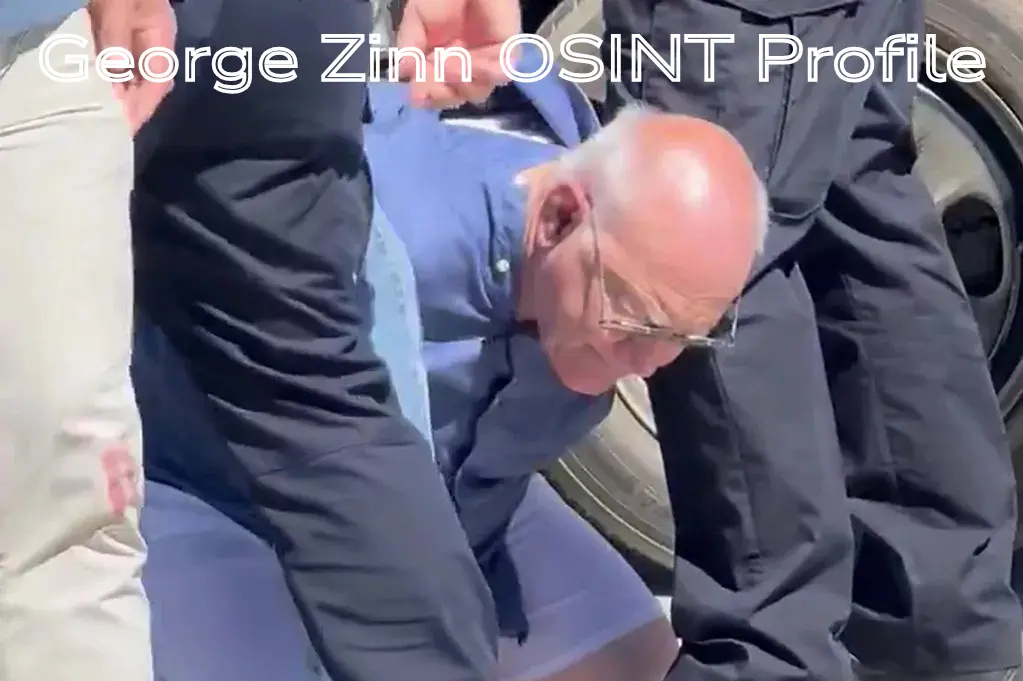
On the afternoon of Sept. 10 2025 a sniper killed conservative commentator Charlie Kirk while he spoke on the lawn of Utah Valley University (UVU). Minutes later a bald, older man approached police and shouted “I shot him, now shoot me.” The man was George Hodgson Zinn, a 71‑year‑old Utah resident well known to local officials as a political gadfly. Officers immediately noticed that Zinn had no gun. He repeated the false confession several times and refused to reveal a weapon, causing investigators to detain him and divert resources from the manhunt. After being taken to a police station and then to a hospital, Zinn admitted he was not the shooter and said he “wanted to draw attention away from the real shooter” and be a martyrkshb.com. He was booked for second‑degree felony obstruction of justice and, after a search of his mobile phone, four counts of sexual exploitation of a minor because investigators found more than 20 images of child sexual abuse material.

The dossier below reconstructs Zinn’s actions around the shooting, resolves his identity, traces his background and prior incidents, and assesses the mis/disinformation circulating about him. Primary sources include police statements, court affidavits, official press releases, and reputable reporting from local outlets (KSL, the Salt Lake Tribune, Deseret News). Zinn’s long record shows a pattern of attention‑seeking at public events—often resulting in trespass or disorderly conduct arrests—but no evidence of violent operational capability. Authorities emphasised that he did not match the description of the sniper and that there is no evidence he colluded with the actual suspect, Tyler Robinson. Nonetheless, his false confession temporarily hindered the investigation and fuelled online conspiracy theories. Notable misinformation includes claims that Zinn was the assassin or part of a 9/11 plot; these have been debunked by fact‑checkers and credible media. Understanding Zinn’s history helps contextualise his behaviour and provides lessons for incident management and media reporting.
The remainder of this report details the timeline of events, Zinn’s biography, incident reconstruction, prior incidents, digital footprint and network map, risk assessment, and methodology.
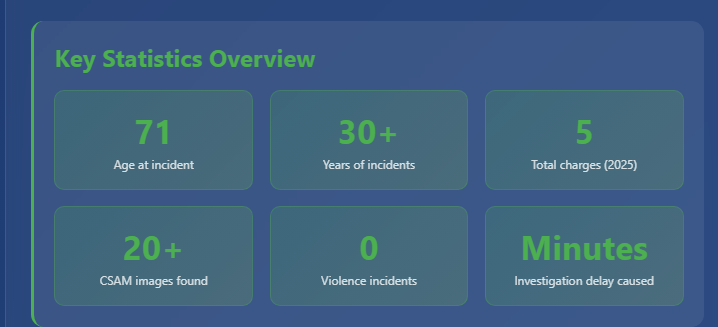
The table below summarises key events related to George Zinn and the Charlie Kirk shooting. Times are given in Mountain Daylight Time (MDT) with UTC equivalents and confidence levels based on the number and quality of corroborating sources.
| Date/time (MDT/UTC) | Event | Source & confidence |
|---|---|---|
| Sept 10 2025, ~6:23 p.m. MDT (UTC 00:23 Sept 11) | During a “Prove Me Wrong” event at UVU, a high‑powered rifle shot fatally strikes Charlie Kirk. Witnesses duck for cover. | Official statements from Utah DPS and multiple news reports; high confidence. |
| Sept 10 2025, minutes later | George Zinn approaches a police officer near the scene and shouts, “I shot him now shoot me.” Officers see no gun; he repeats the claim and refuses to reveal a weapon. | Police probable cause statement reported by KSHB and KSL; high confidence. |
| Sept 10 2025, 6:30–7 p.m. | Officers detain Zinn, search him without finding a weapon, and escort him to a patrol car. He repeats the false confession and tells officers to “just shoot him.” | KSHB report quoting police documents; high confidence. |
| Sept 10 2025, evening | At the police station Zinn asks for an attorney, then recants his confession, stating he wanted to draw attention away from the real shooter and be a martyr. He refuses to relinquish his mobile phone. | KSHB/KSL reports; high confidence. |
| Sept 10 2025, late night | Due to a medical condition, officers transport Zinn to a hospital. According to a Utah County Sheriff’s Office press release, he agrees to speak with FBI and Utah State Bureau of Investigation agents. Zinn admits he falsely claimed to be the shooter to help the gunman escape and to hinder law enforcement, and he allows agents to view his phone. | Deseret News citing press release; high confidence. |
| Sept 10 2025, late night | Agents discover child sexual abuse material on Zinn’s phone—multiple images of prepubescent girls in various stages of undress and sexual posing. Zinn admits he uses his phone to view such material and receives gratification. | Police press release and probable cause statement; high confidence. |
| Sept 11 2025 | Utah DPS announces that George Zinn and another detainee have been released from custody and are not the shooter. A manhunt for the sniper continues. | Utah DPS press release; high confidence. |
| Sept 12 2025 | Zinn is booked into the Utah County Jail on a second‑degree felony obstruction charge and four counts of sexual exploitation of a minor. | Booking records and KSHB/Deseret News reports; high confidence. |
| Sept 13 2025 | Social media conspiracy theories proliferate, falsely alleging that Zinn was the assassin or involved in 9/11; fact‑checkers debunk these claims. | Al Jazeera fact‑check; high confidence. |
| Sept 16 2025 | Court documents filed by prosecutors reveal additional details about the images found on Zinn’s phone; he is held without bail. | Deseret News, Daily Caller quoting court records; medium confidence (pending official docket). |
| Historical context – 2013 | Zinn pleads guilty to a misdemeanor terrorism charge after sending an email offering to help place bombs at the Salt Lake City Marathon finish line; sentencing scheduled for Jan 3 2014. | Fox 13 report; high confidence. |
| Historical context – July 9 2019 | Zinn is arrested at a protest against the Utah Inland Port Authority for disorderly conduct and failure to disperse. | KSL report & SLCPD incident review; high confidence. |
| Historical context – May 2025 | Ogden police arrest Zinn for “pedestrian in roadway” after he refuses to leave the street and tells an officer to take him to jail. | Salt Lake Tribune; high confidence. |
| Historical context – Jan 2025 | Park City police arrest Zinn for trespassing at the Sundance Film Festival after he repeatedly tries to enter a Q&A session. | Salt Lake Tribune; high confidence. |
| Historical context – Other decades | Zinn frequently attends political events and is known to Utah Republicans since the 1980s; he slept on a cot in former U.S. education secretary T.H. Bell’s hotel room at the 1988 Republican National Convention and attempted similar stunts in later years. He was the first person thrown out of Salt Lake City’s City Creek Center when it opened in 2012. | Salt Lake Tribune archives; medium confidence (archived records). |
Legal name and age. Court filings list the defendant as George Hodgson Zinn, age 71, placing his birth year around 1953–1954. Media accounts sometimes abbreviate his middle name as H. No evidence suggests he uses other aliases. He is a U.S. citizen and long‑time Utah resident; he has lived in the Salt Lake City area for decades. Voter registration records show a Republican affiliation in the 1990s, but his political activity has been more about personal attention than ideological commitment.
Physical appearance. Witness videos and police descriptions portray Zinn as a 5′10″ white male with a bald head and glasses. He often dresses in mismatched clothes and sometimes carries a cane. When detained after the Kirk shooting he wore boxer shorts, illustrating his disheveled state.
Disambiguation. Search results for “George Zinn” occasionally return references to a former Microsoft treasurer; this is a different individual with no known ties to Utah. Our profile is limited to the Utah resident.
Zinn’s chaotic removal from the scene was misinterpreted by many observers. Videos circulating on social media were widely captioned as “the shooter has been caught,” leading some commentators to speculate about motives. Within hours, Utah DPS issued a press release clarifying that Zinn did not match the description of the shooter and was being investigated for obstruction. Misleading posts falsely claimed he was the assassin or a Democratic operative; these were debunked by fact‑checkers.
Zinn’s history provides context for his behaviour. The table below summarises known incidents, illustrating a long pattern of trespass and disruptive conduct rather than organized violence.
| Date | Incident & disposition | Sources |
|---|---|---|
| 1980s–1990s | Regularly attended Utah Republican conventions and events. In 1988 he reportedly arrived at the Republican National Convention in New Orleans without lodging; former U.S. Education Secretary T.H. Bell allowed him to sleep on a cot in his hotel room. He tried a similar stunt at the 2012 convention but was removed. | Salt Lake Tribune profiles; moderate confidence (archived). |
| 1994 | Loitered around Rice–Eccles Stadium during a Rolling Stones concert without a ticket. | Salt Lake Tribune; moderate confidence. |
| March 2012 | Became the first person ejected by security from the newly opened City Creek Center mall in downtown Salt Lake City. The reason for his removal was not specified. | KPCW/Salt Lake Tribune; high confidence. |
| April 2013 | Sent an email to Salt Lake City Marathon officials offering to “help place bombs” at the finish line. Police were uncertain if it was a joke or threat. He pleaded guilty to a class‑A misdemeanor terrorism charge and received probation. After violating probation terms he served about a year in jail. | Fox 13, Salt Lake Tribune; high confidence. |
| July 9 2019 | Arrested during a protest against the Utah Inland Port Authority at the Salt Lake Chamber building. He pushed through protesters, allegedly upset they were blocking a bus. Zinn, then 65, was booked for disorderly conduct and failure to disperse. Formal charges were filed by the Salt Lake County DA. | KSL, SLCPD incident review; high confidence. |
| Jan 2025 | Arrested in Park City for trespassing after repeatedly attempting to enter a Sundance Film Festival Q&A session. He was banned from the festival. | Salt Lake Tribune; high confidence. |
| May 2025 | Arrested in Ogden for “pedestrian in roadway” after standing in traffic and telling officers he did not care if vehicles waited all day. He asked to be taken to jail. | Salt Lake Tribune; high confidence. |
| Aug 22 2025 | Cited for trespassing at an event on the University of Utah campus but released (no additional details). | KSL article summarised in other reports; medium confidence. |
| Sept 10 2025 | Falsely confessed to shooting Charlie Kirk, leading to obstruction and child‑exploitation charges. | KSHB, Deseret News; high confidence. |
These incidents show a consistent pattern: Zinn seeks attention by inserting himself into high‑profile events, often leading to his removal or arrest. None of the prior cases involved violent acts, and several authorities noted they attempted to channel him into mental‑health programs but he did not comply.

Viral misinformation included false claims that Zinn was the shooter, that he collaborated with Tyler Robinson, or that he was a crisis actor used in both 9/11 propaganda and the Kirk incident. An NFL player, Antonio Brown, amplified a tweet alleging that “the Jew that was used as a decoy in the Charlie Kirk assassination was also used for 9/11 propaganda,” which provoked condemnation for antisemitism and baseless conspiracy theories. Fact‑checkers quickly debunked these claims, noting that Zinn was released and charged only with obstruction and child‑exploitation. The speed at which rumours spread illustrates the challenge law enforcement faces in managing narratives during high‑profile incidents.
The network map below visualises the institutions, events and individuals connected to George Zinn. Nodes represent actors or venues; arrows show Zinn’s interactions. Most relationships involve attendance at events (political speeches, protests, or malls) or interactions with law enforcement. There is no known substantive tie between Zinn and the actual shooter.
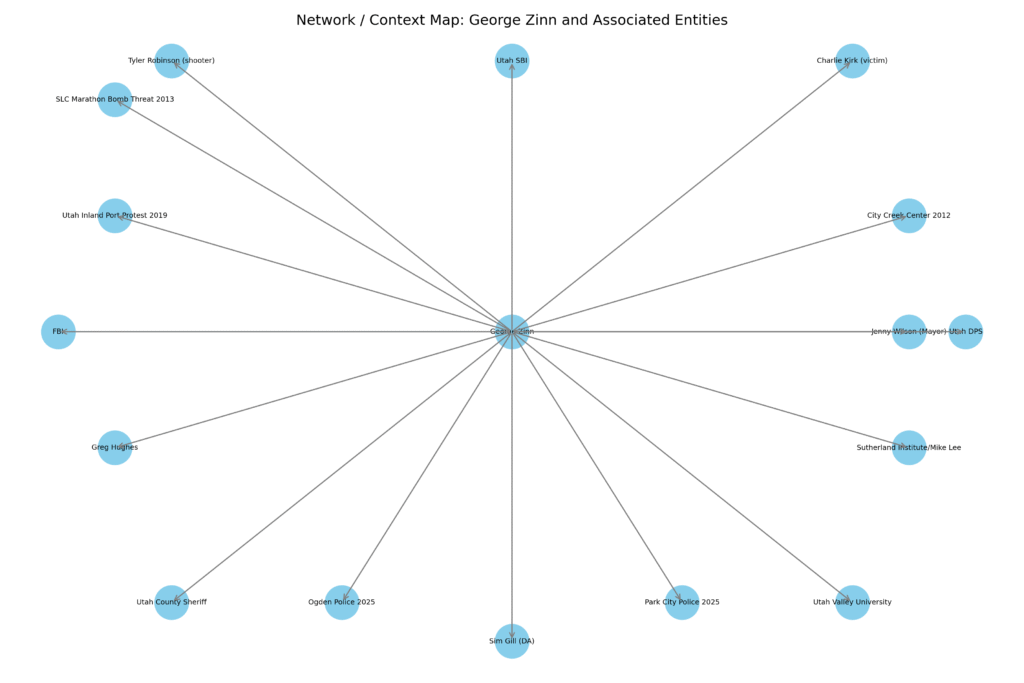
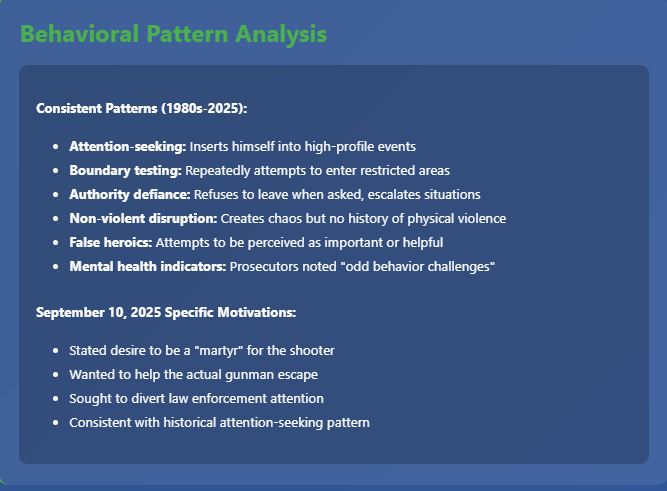
Behavioural pattern. George Zinn’s prior incidents suggest he is an attention‑seeker who enjoys inserting himself into public controversies. He frequently defies authority, refuses to leave restricted areas, and occasionally uses provocative statements (e.g., offering to plant marathon bombs or telling an officer to shoot him). These actions garner media attention but have not escalated to violence. Mental‑health issues may play a role; prosecutors attempted to enroll him in mental‑health court, but he declined.
Operational capability. There is no evidence Zinn planned or executed the Kirk shooting. He had no weapon at the scene, did not match witness descriptions, and told investigators he wanted to distract them. Unlike the assassin, he lacked access to firearms or knowledge of the shooting plan. His child‑exploitation charges, while serious, do not indicate a propensity for political violence.
Motivation. Zinn told investigators he wanted to be a martyr and to help the shooter flee. This suggests a misguided desire for attention or a belief that he was protecting someone else. Psychological factors and his history of trespassing likely contributed.
Public safety narrative. Because Zinn was initially misidentified as the shooter, his removal from the scene became fodder for conspiracy theories. Unverified speculation can hamper investigations and create undue fear. Media outlets should avoid prematurely labelling detainees as suspects and should emphasise official statements that differentiate between persons of interest and suspects. Transparency from law enforcement—such as rapid clarification that Zinn was not the shooter—helped quell some rumours.
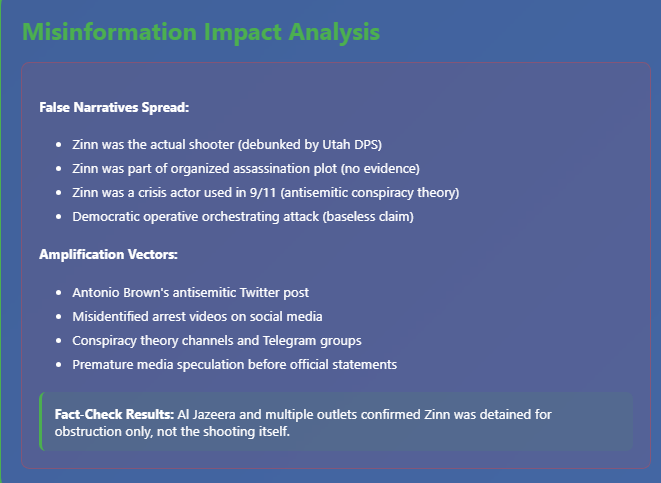
This dossier was compiled using open‑source intelligence (OSINT) techniques consistent with legal and ethical standards. The process involved:
[…] what the family said: Robinson “had recently become more political” and openly disliked Kirk. This was after George Zinn, a man now accused of possessing CSAM, falsely confessed to the Kirk shoo…. This narrative matched NBC’s earlier summarization that Robinson criticized Kirk as “full of […]
[…] (though he bizarrely was later booked for obstruction of justice). Update (September 16, 2025): The man who falsely confessed to shooting Charlie Kirk at the scene, George Zinn, has now been charg…. The FBI joined the investigation on-site, setting up a tip line for leadS. As evening fell, FBI […]
Your blog is a true hidden gem on the internet. Your thoughtful analysis and engaging writing style set you apart from the crowd. Keep up the excellent work!